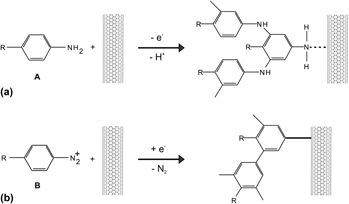Crossref Citations
This article has been cited by the following publications. This list is generated based on data provided by
Crossref.
Komarova, Natal’ya S.
Krivenko, Alexander G.
Ryabenko, Alexander G.
and
Naumkin, Alexander V.
2013.
Active forms of oxygen as agents for electrochemical functionalization of SWCNTs.
Carbon,
Vol. 53,
Issue. ,
p.
188.
Pachauri, Vivek
Kern, Klaus
and
Balasubramanian, Kannan
2013.
Field-effect-based chemical sensing using nanowire-nanoparticle hybrids: The ion-sensitive metal-semiconductor field-effect transistor.
Applied Physics Letters,
Vol. 102,
Issue. 2,
Saikia, Nayan Jyoti
Ewels, Chris
Colomer, Jean-François
Aleman, Belen
Amati, Matteo
Gregoratti, Luca
Hemberg, Axel
Thiry, Damien
Snyders, Rony
and
Bittencourt, Carla
2013.
Plasma Fluorination of Vertically Aligned Carbon Nanotubes.
The Journal of Physical Chemistry C,
Vol. 117,
Issue. 28,
p.
14635.
Primo, Emiliano N.
Cañete-Rosales, Paulina
Bollo, Soledad
Rubianes, María D.
and
Rivas, Gustavo A.
2013.
Dispersion of bamboo type multi-wall carbon nanotubes in calf-thymus double stranded DNA.
Colloids and Surfaces B: Biointerfaces,
Vol. 108,
Issue. ,
p.
329.
Kulakovskaya, S.I.
Kulikov, A.V.
Sviridova, L.N.
and
Stenina, E.V.
2014.
Electrochemical and Electron Paramagnetic Resonance Study of the Mechanism of Oxidation of Phenazine-di-N-oxide in the Presence of Isopropyl alcohol at Glassy Carbon and Single-Walled Carbon Nanotube Electrodes.
Electrochimica Acta,
Vol. 146,
Issue. ,
p.
798.
Kulakovskaya, S. I.
Krivenko, A. G.
Komarova, N. S.
Kulikov, A. V.
and
Shestakov, A. F.
2014.
Electrochemical and ESR study of the mechanism of oxidation of phenazine-di-N-oxide in the presence of cyclohexanol on glassy carbon and single-walled carbon nanotube electrodes.
Russian Journal of Electrochemistry,
Vol. 50,
Issue. 1,
p.
1.
Tesio, Alvaro Yamil
Granero, Adrian Marcelo
Vettorazzi, Nelio Roberto
Ferreyra, Nancy Fabiana
Rivas, Gustavo Adolfo
Fernández, Héctor
and
Zon, María Alicia
2014.
Development of an electrochemical sensor for the determination of the flavonoid luteolin in peanut hull samples.
Microchemical Journal,
Vol. 115,
Issue. ,
p.
100.
Holzinger, Michael
Le Goff, Alan
and
Cosnier, Serge
2014.
Supramolecular immobilization of bio-entities for bioelectrochemical applications.
New J. Chem.,
Vol. 38,
Issue. 11,
p.
5173.
Jiang, Tao
2014.
The electric field screening and crossing point shift effects in coated carbon nanotubes.
Applied Physics A,
Vol. 116,
Issue. 2,
p.
629.
Balasubramanian, Kannan
and
Kern, Klaus
2014.
25th Anniversary Article: Label‐Free Electrical Biodetection Using Carbon Nanostructures.
Advanced Materials,
Vol. 26,
Issue. 8,
p.
1154.
Komarova, Natal’ya S.
Krivenko, Alexander G.
Ryabenko, Alexander G.
Naumkin, Alexander V.
Maslakov, Konstantin I.
and
Savilov, Sergey V.
2015.
Functionalization and defunctionalization of single walled carbon nanotubes: Electrochemical and morphologic consequences.
Journal of Electroanalytical Chemistry,
Vol. 738,
Issue. ,
p.
27.
Prieto-Simón, B.
Bandaru, N.M.
Saint, C.
and
Voelcker, N.H.
2015.
Tailored carbon nanotube immunosensors for the detection of microbial contamination.
Biosensors and Bioelectronics,
Vol. 67,
Issue. ,
p.
642.
Zuccaro, Laura
Krieg, Janina
Desideri, Alessandro
Kern, Klaus
and
Balasubramanian, Kannan
2015.
Tuning the isoelectric point of graphene by electrochemical functionalization.
Scientific Reports,
Vol. 5,
Issue. 1,
Zuccaro, Laura
Tesauro, Cinzia
Kurkina, Tetiana
Fiorani, Paola
Yu, Hak Ki
Knudsen, Birgitta R.
Kern, Klaus
Desideri, Alessandro
and
Balasubramanian, Kannan
2015.
Real-Time Label-Free Direct Electronic Monitoring of Topoisomerase Enzyme Binding Kinetics on Graphene.
ACS Nano,
Vol. 9,
Issue. 11,
p.
11166.
Kim, Han Seul
and
Kim, Yong-Hoon
2015.
Recent progress in atomistic simulation of electrical current DNA sequencing.
Biosensors and Bioelectronics,
Vol. 69,
Issue. ,
p.
186.
Gutierrez, Fabiana A.
Rubianes, María D.
and
Rivas, Gustavo A.
2016.
Electrochemical sensor for amino acids and glucose based on glassy carbon electrodes modified with multi-walled carbon nanotubes and copper microparticles dispersed in polyethylenimine.
Journal of Electroanalytical Chemistry,
Vol. 765,
Issue. ,
p.
16.
Lee, Juho
Choi, Ji Il
Cho, Art E.
Kumar, Satish
Jang, Seung Soon
and
Kim, Yong‐Hoon
2018.
Origin and Control of Polyacrylonitrile Alignments on Carbon Nanotubes and Graphene Nanoribbons.
Advanced Functional Materials,
Vol. 28,
Issue. 15,
Kulakovskaya, S.I.
Kulikov, A.V.
Zyubina, T.S.
Zyubin, A.S.
Konev, D.V.
Sviridova, L.N.
Stenina, E.V.
Ryabenko, A.G.
and
Zolotukhina, E.V.
2021.
Role of non-covalent interactions at the oxidation of 2,5-di-Me-pyrazine-di-N-oxide at glassy carbon, single-walled and multi-walled carbon nanotube paper electrodes.
Carbon Trends,
Vol. 4,
Issue. ,
p.
100057.
Iost, Rodrigo M.
2022.
Advances in Bioelectrochemistry Volume 1.
p.
53.
Verma, Sarika
Dhangar, Manish
Bajpai, Harsh
Chaturvedi, Kamna
Mohapatra, Ranjan K.
Khan, Mohd. Akram
Azam, Mohammad
Al-Resayes, Saud I.
and
Srivastava, Avanish Kumar
2023.
X-ray radiation shielding and microscopic studies of flexible and moldable bandage by in situ synthesized cerium oxide nanoparticles/MWCNTS nanocomposite for healthcare applications.
RSC Advances,
Vol. 13,
Issue. 13,
p.
8594.





